2 color codes – Analog Way VERTIGE - Ref. VRC300 User Manual User Manual
Page 14

14
3.2 Color codes
7- Transition section
8- Control Transition
6- Edit section
This section enables the operator to use the T-Bar
and sliders for transitions. They are motorized in
order to see the current state of the selection.
The ALPHA button will be used to switch the Transition section to ALPHA:
- When the ALPHA mode is disabled (key backlight turned off), sliders allow to individually mix each screen
- When the ALPHA mode is enabled (key illuminates in
RED
), each slider is assigned to a selection of layers
and allows to control their master opacity (transparency).
The CUE SEQUENCE button is used to switch the Control Transition section to CUE SEQUENCE mode in order
to control the cue sequence playback.
The Vertige™ buttons were designed with a handy color code to guide users, avoid mistakes, and give a
constant status of the device. Thus, all Vertige™ buttons have two or three different states (and colors),
depending on their function and their current state.
All standard buttons mapped to an available function/slot light up
GREEN
.
All contextual buttons mapped to an available function/slot light up
BLUE
.
Any of these buttons turns
YELLOW
when the function/slot is selected/filled.
If one of these buttons blinks
YELLOW
, it means the function/slot is waiting for a confirmation (a second
consecutive press).
All double sized buttons like PROGRAM or PREVIEW are either OFF or lighten up in
RED
to indicate the
current mode.
TAKE CUT & TAKE buttons are always
RED
and will BLINK when there is a Take in progress.
This section allows the operator to edit the selected
layers in three different ways: roughly by the
joystick, finely by coders or directly by numpad. The
block containing the numpad is contextual and also
provides access to pages of shortcuts, tools, layer
presets (position, size, border, effect …).
3.2 Color codes
IMPORTANT: The front panel is available as soon as an iteration is loaded. The front panel is
dedicated to presets and transitions and the touch screen state will never interfere with it.
